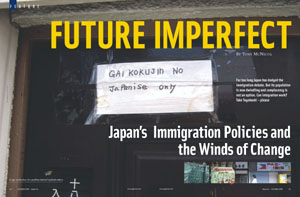Future Imperfect
Back to Contents of Issue: October 2003
|
|
|
|
by Tony McNicol |
|
 TOYOHASHI IS A MEDIUM-SIZED city in the middle of Japan. Local residents will tell you that their home city has a population of about 400,000, makes some of Japan's most delicious chikuwa (fish cake) and has an excellent surfing beach. They might even point out Toyohashi's futuristic Shinkansen station.
TOYOHASHI IS A MEDIUM-SIZED city in the middle of Japan. Local residents will tell you that their home city has a population of about 400,000, makes some of Japan's most delicious chikuwa (fish cake) and has an excellent surfing beach. They might even point out Toyohashi's futuristic Shinkansen station.
In short, Toyohashi is an average sort of place in a conservative and some might say ultra-Japanese part of Japan. But Toyohashi also has an energetic and conspicuously un-Japanese population: 10,000 South American immigrant workers, most of whom are Brazilians and Peruvians.
What makes Toyohashi special is that it could possibly provide a template for the future of the nation as a whole. A UN report on replacement migration and declining birth rates estimates that if present trends continue, Japan's population will have declined by 22 million in 2050. To fill the gap completely through immigration, the nation would have to welcome an average of 381,000 foreign workers per year all the way to 2050. Even with only a moderate influx of immigrants, every city in Japan could become another Toyohashi.
Is this economically and politically feasible? Those who think not are already casting about for alternatives. A demographic sea change which some argue is an economic necessity would mean that the immigrant population of Japan would swell from around 1 percent now to 17.7 percent by the middle of this century.
Of the nearly 2 million foreigners in Japan now, over half are Korean and Chinese, many of whom live in long established communities. Of the other million, over 300,000 are recently arrived Brazilians and Peruvians.
Sergio Okamoto arrived in Toyohashi in March 1990, close on the heels of new visa rules designed to encourage immigration by Brazilians, Peruvians and Argentines of Japanese ancestry. Born in Brazil to Japanese parents, Okamoto speaks fluent Japanese, Portuguese and English. At first, and like most South Americans, he found work in a factory. But now he works for a recruitment company supplying workers to a Toyohashi factory.
According to Okamoto, there is plenty of work for South Americans, recession or no recession. Foreign workers are still almost the only ones ready to do the most difficult, unpleasant and often dangerous jobs. Despite high unemployment in Japan and competition from some often over-qualified and desperate Japanese workers, it is still possible to find work paying JPY300,000 to JPY350,000 per month (including overtime).
Most of the Brazilians employed by Okamoto's company work 40 to 50 hours overtime per week, saving money to send home.
"If you stay here for a couple of years, you can buy a house, buy land and have capital to start a business [in Brazil]."
Professor Hiroshi Komai of Tsukuba University in Ibaraki has studied immigration into Japan. He says that Brazilians are no longer confined to the factories and have started finding other types of work -- everything from being golf course caddies to caretakers for the aged.
In short, the immigrant economy is hollowing out just like the rest of the Japanese economy. Manufacturing jobs are going east to China, and South Americans are turning to the service sector. Japan's public policy planners in the early 90s may have imagined immigrants sweating unseen through automobile and electronics factory night-shifts, but a decade on many are working in shops, restaurants and offices -- not least in the small economy of services catering to the immigrant communities themselves.
The newcomers are more likely to be from poorer countries elsewhere in Southeast Asia. Komai believes that the government may decide to open up the geriatric care sector to Asiatic foreign immigrants. By some estimates, in 2050 Japan will have more than 33 million additional aged persons needing care.
However, Komai doesn't believe that this sector alone can provide enough work for the immigrants Japan will need to sustain its population -- and its tax income. What's more, the demand for general unskilled labor has been shrinking for the last 10 years.
"The industrial structure has already changed," Komai says. "We have no capacity [to absorb unskilled immigrants]."
He says the die was cast when Japan shied away from large-scale immigration at the beginning of the 90s -- and the nation's manufacturers found cheap labor in China.
So with as many as 17 million new residents to find by 2050, the Japanese government is now considering a different kind of immigration. For a number of years it has been chasing highly skilled foreign workers -- mainly for the IT industry.
To come to Japan, job-seekers need high-level university qualifications from their own country or 10 years of experience in their field. Pasona-Tech's Chinese job-seekers are all graduates from universities in their own country, but this is very much the exception among highly skilled Chinese employees in Japan. Most have graduated from Japanese universities, many with scholarships from the Japanese government. According to the Ministry of Education, about a third of all foreign students in Japanese universities are Chinese.
Significantly, Japan is not attracting significant numbers of highly skilled graduates from Chinese universities themselves -- or from universities from anywhere else in the world, for that matter. Instead, Japan is largely drawing from a small pool of foreign students committed to Japan because of their time spent in Japanese universities.
Komai sees this as a sad sign of Japan's failure to attract international talent. Unfamiliar management techniques and pay scales based on seniority put off potential immigrants. Highly skilled workers with families worry whether the Japanese school system will be able to teach their children English. Will their children be able to compete in the international job market when they grow up?
If Japan can't absorb unskilled immigrants and can't attract highly skilled immigrants, what can be done to fill the gap in the working age population?
According to the UN population division, in order to redress the balance completely, Japan could raise the retirement age to 77 years. Even now, senior citizens have an average 15 to 20 mostly healthy years left after they retire. Many are already turning to part-time or full-time work to supplement their income. Anyone wondering what a Japan full of senior citizen workers will look like should just flag down a taxi in Tokyo. According to Tokyo's largest private taxi drivers union, more than half of their members are over 60, and 10 percent are in their 70s.
Obviously, the most direct way to address falling population would be to try to raise the birthrate. A present, Japan's fertility rate is about 1.5 children per woman in Japan. Most of the world's developed countries are facing a similar problem. Italy, for instance, has an even more acute problem, with a birthrate of 1.2 children per woman.
Komai points out that Japan also has the lowest rate of extra-marital birth in the developed world. Women who want children, but who don't want to get married, have no choice but to stay childless. Countries like Canada and some of the Northern European states have tried to break the link between marriage and childbirth in an attempt to raise fertility rates. But in Japan, the mostly married men in suits in the Diet seem unwilling to explore this option. At least, not yet.
Whether Japan produces more babies, employs more senior citizens, does both or does neither, it seems likely that the number of foreigners in Japan will continue to increase. But even so, many people of non-Japanese origin living in Japan feel that the government is doing little to combat deeply ingrained and institutional discrimination against them.
Debito Aruhido (born in the United States as David Aldwinckle) became a naturalized Japanese citizen in 2000. When an onsen near his home in Hokkaido put up signs barring foreigners, he protested and launched an ongoing court struggle.
He quickly discovered that Japan has no law on its statute books explicitly outlawing racial discrimination. Yet Aruhido won the first stage of his case against the onsen. In his words, the decision explicitly stated that "the onsen overdid it. It went beyond the boundaries of what is called 'rational discrimination' in Japan ... beyond the socially accepted bounds of discrimination. But it doesn't say that it is illegal because it is racial discrimination."
Aruhido believes that fundamental changes in attitude are needed. "There is this overwhelming canard that Japan is a mono-cultural, mono-ethnic society where there aren't any ethnic minorities. In the UN, Japan argues that the Ainu, the Burakumin and the Okinawans are not racially different, therefore the discrimination against them isn't racial."
He says that the government hasn't passed legislation against racial discrimination on the absurd grounds that no one would actually be protected by it. The vast majority of assimilated foreigners are Asian, and therefore can't possibly be victims of racial discrimination, in the government's eyes. If there is discrimination, it is because of the passports people carry -- not their race.
But with a swelling community of immigrant workers, how long can Japan maintain its self-image of a country united by racial identity? Will Japan take its first baby steps towards multiculturalism?
Apart from anti-racism laws, Aruhido calls for immigrants to be able to keep their own passports when they become Japanese citizens. He also proposes a law to let children born in Japan automatically become Japanese citizens. "About half [of registered foreigners in Japan] are born in Japan. In any other developed country they would not be considered foreigners any more."
He has been in his job since 1997, on an assembly line with robots that slice through sheet metal with pressurized water. He says that although South Americans and Japanese in his factory have generally got along, the recent frictions make him sick. He works the night shift and accuses his Japanese co-workers of napping on the job.
"[The Japanese workers] think maybe because we are foreigners we have to only work, and that because they are Japanese, and we are in Japan, they get to sleep... Maybe they think we are robots."
The main problem for South Americans in the factories is their low status and poor conditions. The recruitment company system means that the factories are largely free from dealing with troublesome responsibilities, like providing severance pay or compensation in the event of injury.
"If I get fired, I get nothing," he says.
Japan will have to move mountains to integrate large numbers of non-Japanese into the nation's economy and society. One part of Japan that seems to be trying hard is Nagano prefecture. Its reformist governor, Yasuo Tanaka, is well known for opposing pork barrel construction projects in the prefecture, but now he's working to build bridges between the Brazilian and Japanese communities. In March, Tanaka received an award from the Brazilian state to thank him for his support of the 18,000 Brazilians in the prefecture.
One effort is the "Santa Project," an education project to support the children of immigrant children. Few Brazilians can afford to send their children to the few privately run Brazilian schools. Dropout rates are high among Brazilian children attending Japanese schools. A spokesman for the charity says that 17 percent of immigrant children in Nagano prefecture are not attending school. "Education is a basic human right," he says. "All children should be educated and [it] is crucial for the future of the children of immigrants. That's why we started the project."
This August, Toyohashi held its annual summer festival. The city's main street was flooded with a colorful parade of floats, musicians and dancers. The festival has long included traditional Japanese dance and music, but recently a hint of South American carnival has crept into the proceedings. South American and Japanese dancers from the local samba schools showed off their moves together, adding an extra and by all accounts welcome flash of color.
Immigrant communities in Japan are still small. But those who wonder how Japan can ever become a multicultural nation are probably right to look for new policies and ideas. Perhaps in a few places, change has already arrived. @
|
|
Note: The function "email this page" is currently not supported for this page.


 With its 15,000-strong immigrant community, Toyohashi may well become a model for the rest of Japan. But one major difference, says Komai, is critical: Future immigrants are unlikely to be South American. "The resource of the Japanese population in Latin America is already exhausted."
With its 15,000-strong immigrant community, Toyohashi may well become a model for the rest of Japan. But one major difference, says Komai, is critical: Future immigrants are unlikely to be South American. "The resource of the Japanese population in Latin America is already exhausted."
 Pasona-Tech is an IT recruitment company founded in 1998 and based in Tokyo. When the Japanese government reacted to a shortage of home-grown IT workers by relaxing visa rules for foreign IT specialists, Pasona-Tech started recruiting eagerly from India. But today, of the 200 IT specialists on their books, over 170 are Chinese. Again, the change can largely be explained by the manufacturing exodus to China. Many tech companies straddle the Sea of Japan with their headquarters and research departments in Tokyo and their factories firmly ensconced in China.
Pasona-Tech is an IT recruitment company founded in 1998 and based in Tokyo. When the Japanese government reacted to a shortage of home-grown IT workers by relaxing visa rules for foreign IT specialists, Pasona-Tech started recruiting eagerly from India. But today, of the 200 IT specialists on their books, over 170 are Chinese. Again, the change can largely be explained by the manufacturing exodus to China. Many tech companies straddle the Sea of Japan with their headquarters and research departments in Tokyo and their factories firmly ensconced in China.
 One suggestion is to encourage people to work longer. Already one in five Japanese are over the age of 65. Aside from the drastic drop in overall population, Japan faces a potentially crushing burden on its pension system. At the moment, every retiree is supported by approximately five working age adults. By 2050, the ratio is expected to be barely one to two.
One suggestion is to encourage people to work longer. Already one in five Japanese are over the age of 65. Aside from the drastic drop in overall population, Japan faces a potentially crushing burden on its pension system. At the moment, every retiree is supported by approximately five working age adults. By 2050, the ratio is expected to be barely one to two.
 Daniel Alberto Harada, 26, works in a Toyohashi factory making roofs for Toyota cars. He works alongside 20 Japanese and 7 Peruvians. He was born and grew up in Argentina, but came to Japan with his Japanese parents during an economic crisis in the mid 90s.
Daniel Alberto Harada, 26, works in a Toyohashi factory making roofs for Toyota cars. He works alongside 20 Japanese and 7 Peruvians. He was born and grew up in Argentina, but came to Japan with his Japanese parents during an economic crisis in the mid 90s.



